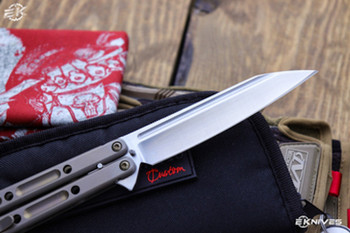Survive with the Butterfly: Why a Custom Butterfly Knife is a Key Survival Tool
Posted by Clayton on Jan 25th 2018
Spanish sailors in the 18th and 19th centuries used the butterfly knife as a tool for everyday use to safely operate canonry. The Spanish butterfly knives were comprised of a steel blade used to cut fuses mated to a brass handle. Brass was used because it doesn’t cause a spark, which prevented unwanted explosions when surrounded by gunpowder.
Traditional balisong style
A balisong, also known as a Batangas knife, is basically a folding pocketknife. Balisongs are constructed of two counter-rotating handles positioned around a tang, which open to expose a single-edged steel blade. Handles are normally made from steel, but wood or brass are commonly found. The handles are latched together to prevent them from opening prematurely. In the hands of a trained user, this knife design can be quickly deployed using one hand.
In 1905, Hemming Cutlery in Connecticut began mass production of the butterfly knife. Popular with American servicemen, it remained a prevalent knife until political scaremongering limited its availability later in the 20th century.
On the other side of the world in Batangas, Philippines, Perfecto de Leon also began producing the balisong in 1905. It developed a huge following after World War II when the Batangueno bladesmiths manufactured custom knives for American servicemen stationed at Subic Naval Base and Clark Air Force Base. Domestically, these were commonly used by Filipinos as a self-defense and pocket utility knife.
To meet U.S. demand and circumnavigate import restrictions, Balisong USA started manufacturing butterfly knives in the late 1970s. This company is now known as Benchmade, which uses the butterfly logo to this day.
Why a Butterfly Knife?
The butterfly knife can be a great part of your everyday carry loadout. Most butterfly knives fit easily into a pocket. Part of their convenience is that they do not require a sheath because the blade sits securely between the handles. No sheath means fewer components are required in order to rapidly deploy the blade.
Microtech Tachyon III Balisong Orange DLC Black 173-1DLCOR
Unlike automatic knives and assisted openers that rely on springs for a rapid, one-handed operation, the butterfly knife only has three main components and relies on simple inertia to deploy. There are no springs to wear out or parts to break, which makes them ideal in a survival situation.
Students of the blade know that there is an entire style of martial arts dedicated to learning and training with the Balisong. Like the Karambit style knife, the Balisong has developed a reliable system for self-defense for everyday survival. A number of different schools in each state teach the art of the Balisong for beginners and experienced individuals. Safe-edged trainer versions are available to facilitate blood-loss-free training sessions.
Restrictions
The butterfly knife was caught up in the switchblade hysteria of the 1950s and is subject to many of the same restrictions on automatic knives today. Many countries outright ban possession or carry of the design, but legality in the U.S. is dictated by individual states. Even in the Philippines, they are restricted in urban areas where it is more difficult to justify them as a working tool.
What to Look for When Purchasing
A custom butterfly knife will use high-grade blade steel with a razor-sharp edge. It will also have a secure latch to keep that razor-sharp blade from impaling you by opening prematurely. A number of high-end U.S. manufacturers produce butterfly knives, like Anthony Marfione’s Microtech Knives.
Microtech Tachyon III Tan Balisong SE Serrated 173-1TN
Survival Tool
As a survival tool, the butterfly knife can be a literal lifesaver. One-handed opening is a must for those times when you don’t have a second hand available — holding off an attacker or vicious dog, holding onto a precariously wrecked vehicle or structure, maintaining pressure on a bleeding wound and so on. Even tasks as innocuous as putting up a tarp shelter require three hands with a regular folder.
With fewer moving parts than an automatic, there is less to go wrong with a butterfly-style blade, making it ideal for austere element use. And as a deterrent, most looters will rethink any nefarious plans when they see someone whip out a balisong with even a modicum of competence. Hollywood has conditioned us to fear anyone with one of those switchblades or ‘martial arts’ knives, so use that to your advantage if you find yourself in a hostile environment.

